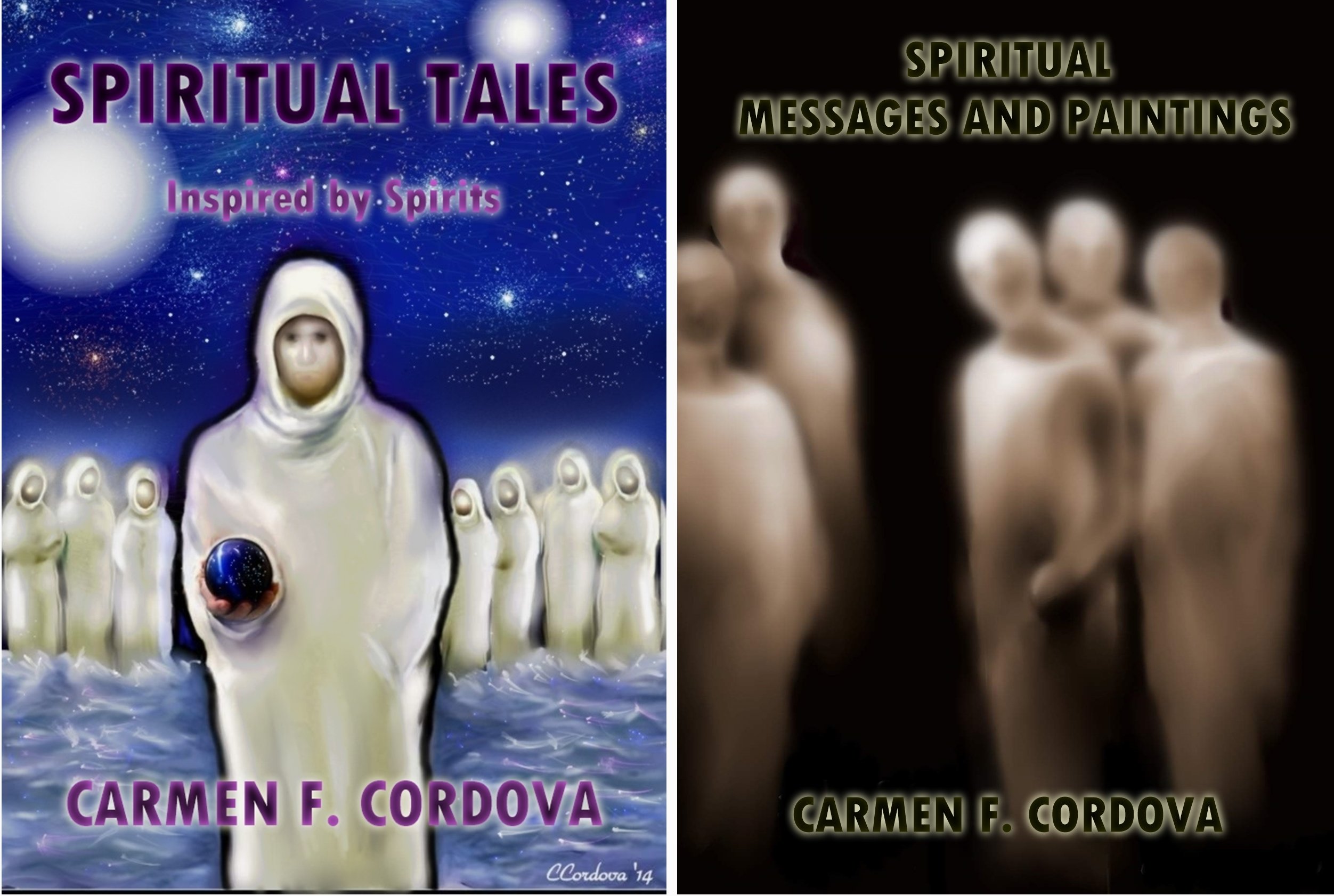Life After Death
Insights and Perspectives on the Afterlife
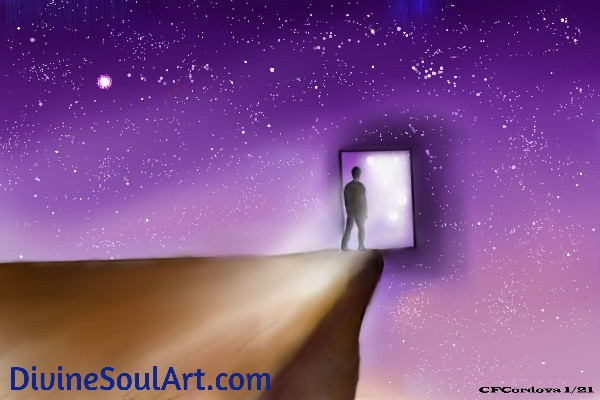
Curious about life after death? This article explores religious beliefs, personal experiences, and scientific research to shed light on what might happen after we die.
Definition and Concept of the Afterlife
Life after death or the afterlife refers to the existence of an individual’s consciousness or identity after the death of their physical body. This concept varies widely across different belief systems, including religious beliefs, spiritual traditions, and philosophical perspectives. In many cultures, the afterlife is seen as a continuation of life after death, where the individual’s soul or spirit continues to exist in a spiritual realm or through reincarnation.
For instance, in many religious beliefs, the afterlife is closely tied to the idea of eternal life, where the soul is considered immortal and continues to exist beyond the physical body. This belief provides comfort and hope, suggesting that death is not the end but a transition to another form of existence. The spiritual realm, often depicted as a place of peace and enlightenment, is a common feature in these belief systems, offering a vision of continued existence beyond the earthly life.
Different cultures and religions have their own unique interpretations of the afterlife. For example, the Hebrew Bible describes the soul as a divine spark breathed into the body by God, signifying its divine origin and eternal nature. This perspective underscores the belief in an immortal soul that transcends physical death. Similarly, other religions and spiritual traditions offer various views on what happens after a person dies, reflecting the rich tapestry of human thought on this profound topic.
Understanding Life After Death and the Immoral Soul
When we die, the spirit separates from the body, embarking on a new phase of existence. Many religious and spiritual traditions propose that life continues in another form after physical death. Life after death suggests continuity before and after our physical bodies perish. This belief can offer comfort, providing hope in the face of death.
The mourning process for loved ones who have passed is often tempered by the hope that they continue to exist in an afterlife. Various cultures and religions hold that the consciousness or identity of an individual survives beyond physical death. This belief in the persistence of the soul or spirit is a cornerstone of many afterlife doctrines, providing solace to the bereaved and a sense of purpose to the living.
Belief systems offer different interpretations of the afterlife. Many cultures envision the afterlife as a spiritual realm where souls persist. Judaism, for instance, focuses on ethical living and good deeds as pathways to a favorable afterlife. For many Jewish people, the emphasis is on their actions in this life rather than on speculations about what occurs after death.
Confucius, too, suggested that understanding life is vital to understanding death, highlighting the interconnectedness of both experiences.
The spirit world is often depicted as a realm for souls after bodily death. This concept spans numerous religious traditions, each offering its own unique perspective on the nature of this spiritual domain.
The Spirit World: A Place Beyond Earth
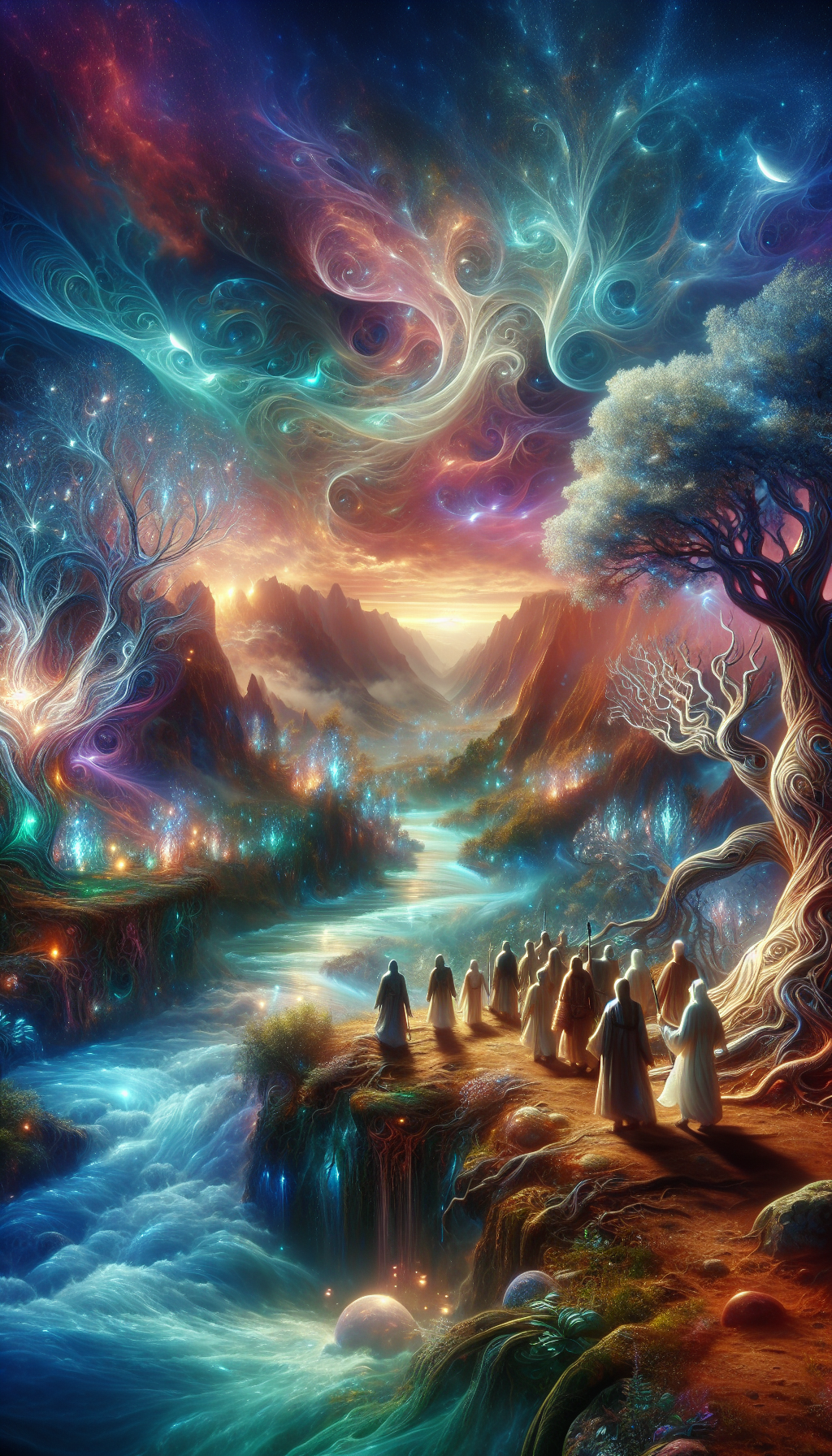
Upon death, the spirit separates from the body and resides in the spirit world. This world is often seen as a transitional phase where spirits exist until they move on to their final destination.
The Druze faith (Arab esoteric religious group), for example, holds a unique view on life after death. They believe that when a person dies, their soul is immediately transferred to a new body- being reborn into another human form and continuing the cycle of life and death.
In Kabbalistic Judaism, reincarnation (gilgul) involves souls returning to fulfill their spiritual purpose, especially in Hasidic traditions. Some Gnostic sects also viewed reincarnation as part of their beliefs, seeing it as a pathway through which souls evolve and learn across multiple lifetimes.
The concept of the immortal soul plays a crucial role in reincarnation and the cycle of birth and rebirth, as it is believed to persist after physical death, undergoing multiple existences and ultimately seeking liberation from this cycle. These beliefs emphasize the spirit world as a place of growth and transformation for the soul.
Indigenous religions often have unique afterlife beliefs, like the Happy Hunting Ground in some Native American cultures. It is an afterlife paradise where, "the souls of deceased hunters and warriors go to continue their skills and enjoy a plentiful supply of game."
Chinese philosophy views death as a natural transition in the cyclical process of existence, highlighting life’s transformative nature.
These diverse views illustrate the wide range of interpretations about the spirit world and its significance in the cycle of life and death.
Exploring these beliefs reveals the spirit world as a complex and multifaceted concept. It serves not only as a place beyond Earth but also as a crucial element in understanding the continuum of existence. This understanding leads us to the topic of resurrection and rebirth, where the spirit’s journey takes on new dimensions.
Resurrection and Rebirth
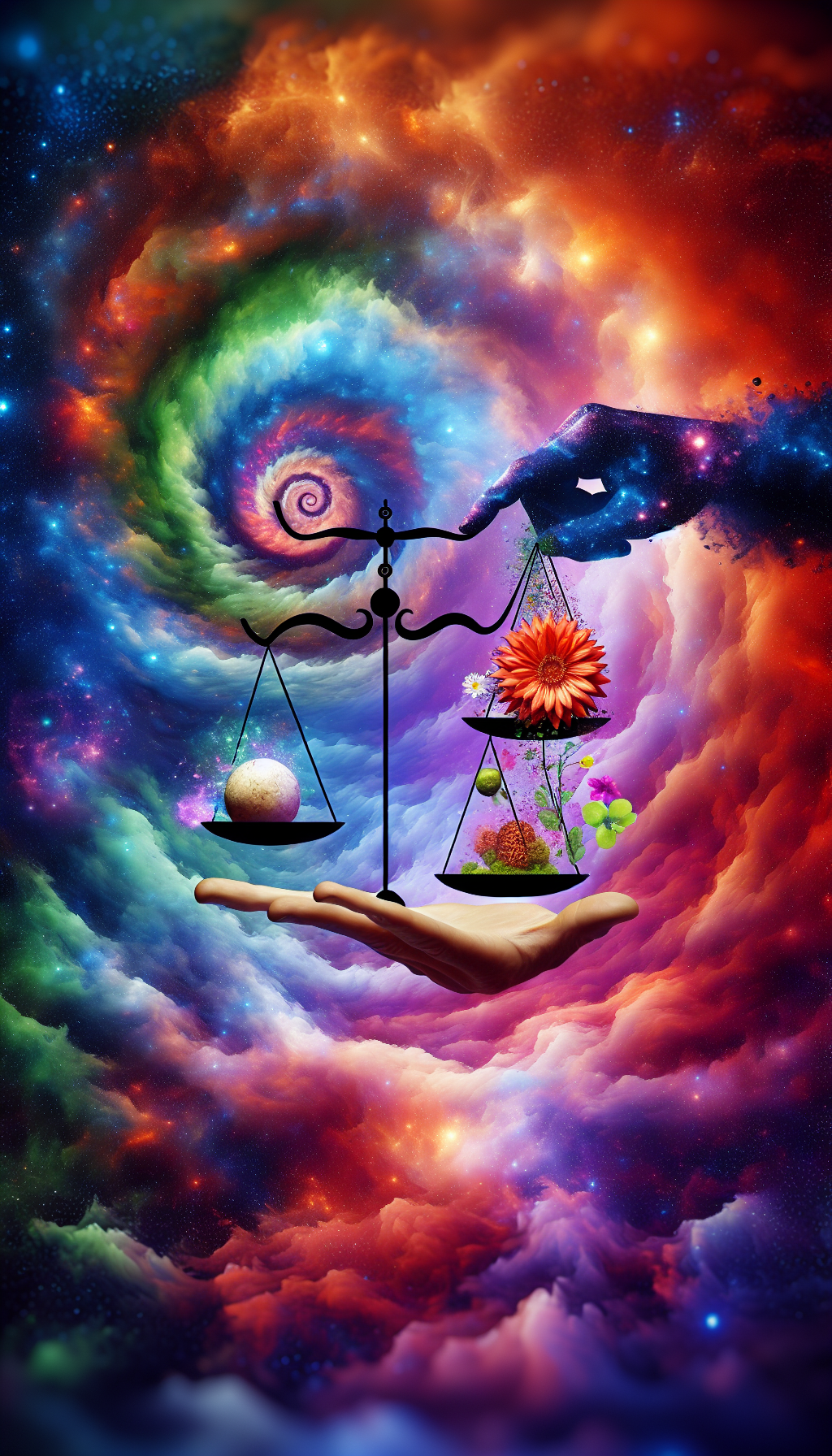
Resurrection and rebirth offer different perspectives on life after death. Some traditions, particularly within Indian religions, view life after death as a continuous cycle of rebirth, influenced by one’s actions in previous lives. Reincarnation involves the soul being reborn into different bodies until it reaches liberation.
When a person dies, various religious and philosophical contexts describe the soul's journey, including immediate resting places and processes of rebirth, emphasizing the continuity of existence beyond physical death. This idea is central to Hinduism, which describes a continuous cycle of birth, death, and rebirth known as samsara, with the ultimate goal being moksha or liberation from this cycle.
Buddhism recognizes samsara but aims for nirvana, a state free of suffering and desire, as the ultimate goal. Karma plays a pivotal role, where actions and intentions significantly affect future experiences, including the afterlife. Good actions and intentions generate positive karma, leading to favorable rebirths, while negative actions result in adverse karma and poorer rebirths.
For some, the concept of resurrection signifies not only life after death but also a transformative hope for restoration and renewal. The promise of a ‘new earth’ reinforces the idea that life and existence continue beyond death, offering a hopeful future. This belief is particularly strong in Christianity, where Easter represents a pivotal moment that fosters optimism against the struggles associated with mortality and bodily resurrection.
The spirit world serves as a transitional phase until resurrection when spirits reunite with perfected bodies. Different faiths interpret this period in various ways, often viewing it as a time to begin waiting for eventual resurrection. This tapestry of beliefs underscores the diverse ways humanity envisions life beyond death.
The Physical Body and the Afterlife
The physical body plays a significant role in many belief systems regarding the afterlife. In some traditions, the physical body is seen as a temporary vessel for the soul or spirit, which continues to exist after death. This view is prevalent in many religious and spiritual traditions, where the body is considered a mere shell that houses the eternal soul.
For example, in Jewish tradition, the physical body is believed to be resurrected in the Messianic Age, reflecting the belief in a future restoration and renewal of the body. This idea emphasizes the interconnectedness of the body and soul, suggesting that the physical body will be perfected and reunited with the soul in the afterlife.
Similarly, in Hinduism, the physical body is seen as a temporary manifestation of the eternal soul, which undergoes a cycle of birth, death, and rebirth. This belief in reincarnation highlights the transient nature of the physical body and the enduring journey of the soul.
These diverse perspectives illustrate the complex relationship between the physical body and the afterlife. While some belief systems emphasize the resurrection or reincarnation of the body, others focus on the soul’s continued existence in a spiritual realm. This multifaceted view of the physical body and its role in the afterlife reflects the rich diversity of human thought on this profound topic.
Judgment and the Afterlife
In Abrahamic faiths, the afterlife is often viewed as a journey to paradise or punishment based on one’s conduct. Many Christians believe that post-death, individuals will encounter God and be judged based on their actions during life. Final judgment involves the resurrection of humanity when Jesus Christ returns, reuniting body and soul for comprehensive judgment.
Individual judgment occurs immediately after death, determining the soul’s destination: Heaven, Hell, or Purgatory. Personal judgment is based on one’s desires, actions, and choices, reflecting the moral and ethical dimensions of life. According to Catholic belief, every person is responsible for their decisions, which impacts their judgment.
The Catholic Church teaches that there are two types of judgment: personal judgment at death and final judgment at the end of time. This duality emphasizes the importance of living a righteous life, as both immediate and ultimate fates are influenced by one’s conduct. These beliefs emphasize moral accountability in shaping one’s afterlife destiny.
Exploring these notions of judgment reveals the afterlife as a realm of moral reckoning, not just a continuation of existence. This understanding sets the stage for exploring the various realms of the afterlife, including heaven, hell, and the celestial kingdom, where souls find their eternal abode.
Heaven, Hell, and Other Realms
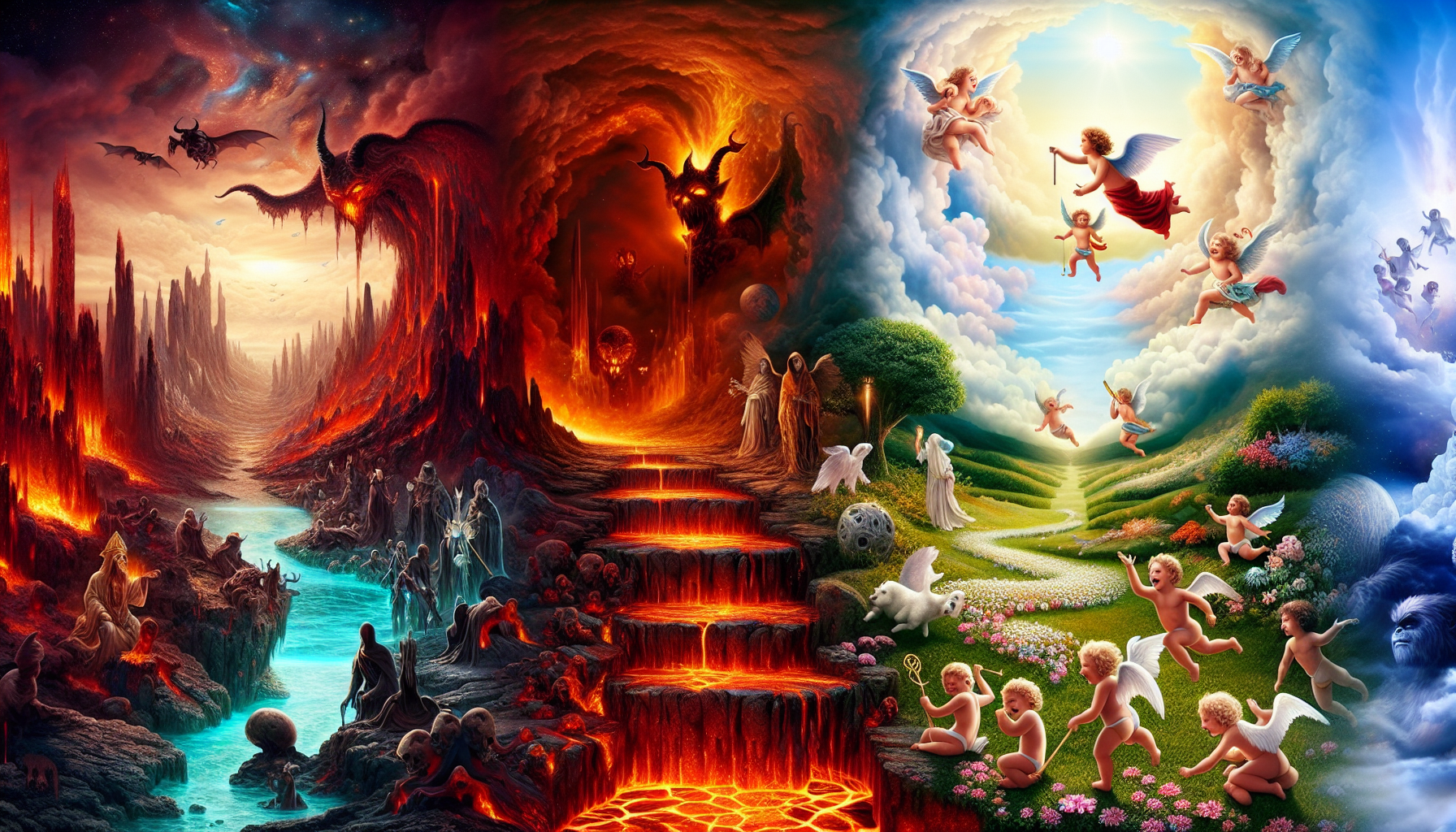
Christianity views heaven as a paradise for believers and hell as a place of punishment for the unrighteous.
Neither heaven nor hell is believed in by many adults, who hold beliefs about an afterlife, such as cyclical existence or a peaceful rejoining with the universe.
These realms serve not only as final destinations but also as moral guidelines that influence the behavior of followers. The belief in heaven and hell reflects a broader understanding of justice and existence, providing a framework for ethical living.
Islam’s afterlife includes heaven (Jannah) for the faithful and hell (Jahannam) for those who defy God’s teachings. Islamic texts vividly describe these realms, emphasizing rewards and punishments based on earthly conduct. The concept of an afterlife in Islam underscores the importance of faith and adherence to divine commandments.
Various cultures and religions hold distinct beliefs about the afterlife, particularly regarding realms such as heaven and hell. These beliefs offer moral guidance and reflect a broader understanding of justice and existence across cultures. The diversity of these beliefs highlights the universal human quest for meaning and moral order in the afterlife.
Exploring these realms reveals they serve as both destinations and moral compasses. This understanding leads us to the next section, where we delve into personal experiences and near-death insights, offering a more intimate glimpse into individual perceptions of the afterlife.
Personal Experiences and Near-Death Insights
Near-death experiences often provide profound insights into what lies beyond death. One person reported feeling peace and belonging during their near-death experience, describing it as a comforting yellow glow. Such experiences often challenge our understanding of consciousness and existence, providing a unique perspective on life after death.
In another near-death experience, a person described observing their medical emergency from a detached perspective, noting a lack of emotional response. These out-of-body experiences suggest that consciousness may persist independently from the physical body, raising intriguing questions about the nature of the soul and the afterlife.
Experiencing two near-death incidents led a person to become more open to the idea of life after death. This individual found comfort in the similarity of their near-death experiences to those documented in scientific literature. This alignment between personal experiences and scientific research underscores the potential validity of near-death phenomena.
Research at the Division of Perceptual Studies (DOPS) includes near-death experiences, past life memories, and deathbed visions. Dr. Bruce Greyson has studied over 1,000 near-death experiences to understand their implications for consciousness. These scientific investigations provide insights into the afterlife, bridging personal experiences and empirical evidence.
The Role of Karma and Moral Conduct
Karma plays a pivotal role in many spiritual traditions, linking actions with afterlife consequences. In Buddhism, karma involves both actions and the intentions behind them. Deliberate deeds carry greater weight in determining future consequences, emphasizing the importance of mindful living.
Jainism extends the principle of karma by emphasizing that thoughts can attract karmic matter. This means moral conduct includes mental dispositions, highlighting the impact of one’s inner life on karmic destiny. Karma operates independently of divine judgment, suggesting individuals are responsible for their actions based on natural laws.
In various spiritual traditions, karma links moral conduct with the cycle of life, death, and rebirth. Adhering to moral conduct shapes one’s karmic destiny, influencing future lives and existence in the afterlife. This interconnectedness between actions and their repercussions underscores the ethical dimensions of life after death and encourages individuals to pursue a life of goodness.
Communicating with the Death
Communication with the dead is a phenomenon that has been reported across various cultures and belief systems. Many people believe that it is possible to communicate with the dead through various means, such as mediumship, channeling, or near-death experiences. These practices are often seen as ways to seek guidance, wisdom, or closure from deceased loved ones.
In ancient Greek tradition, the dead were believed to possess knowledge and wisdom that could be accessed through rituals and ceremonies. These practices were seen as a way to connect with the spiritual realm and gain insights from those who had passed on. Similarly, in modern times, near-death experiences have been reported by many individuals who claim to have communicated with deceased loved ones or experienced a sense of peace and tranquility. These experiences often involve encounters with a bright light or a feeling of being in a serene and comforting place, suggesting a continued existence beyond physical death.
The concept of communication with the dead continues to be explored in various fields, including psychology, philosophy, and spirituality. While some view these experiences as evidence of an afterlife, others see them as psychological phenomena. Regardless of the interpretation, the idea of communicating with the dead remains a fascinating and deeply meaningful topic for many people, reflecting the enduring human desire to connect with the spiritual realm and understand the mysteries of life and death.
This demonstrates that the soul continues to exist even after death.
Philosophical Perspectives on Life After Death
Atheists generally perceive death as the end of consciousness, rejecting the notion of any afterlife. They argue that since we do not exist when death occurs, there is no need to fear it. Agnostics remain uncertain about the afterlife, neither fully rejecting nor accepting religious beliefs.
Plato’s philosophy suggests that physical life is an illusion, with true reality existing beyond death. Plato suggests the soul exists in a higher realm of forms, transcending the physical body. The Stoics saw death as a crucial event giving life significance. They believed that recognizing our mortality can lead to a more meaningful existence, emphasizing the importance of living virtuously.
Epicurus argued that death is irrelevant to our experiences and should not be feared since we do not exist when it occurs, highlighting the non existence of our consciousness at that moment. Deleuze challenges traditional views by asserting that life is an ongoing process rather than a concept defined by death. Heidegger, meanwhile, posits that awareness of our mortality defines human existence and drives us to seek meaning in life.
These perspectives highlight the varied ways thinkers have approached life after death. Each viewpoint offers a unique lens through which we can understand our existence, encouraging us to reflect on the deeper implications of mortality and the afterlife.
Scientific Investigations into the Afterlife
Scientific investigations into the afterlife focus on understanding consciousness and its potential survival beyond physical death. Recent studies have measured brain functions during near-death experiences to determine if consciousness can exist separately from the brain. These investigations challenge traditional science boundaries, exploring consciousness and its persistence after bodily death.
Parapsychological research explores phenomena like mediumship, where individuals claim to communicate with spirits. This research raises questions about the nature of existence after death, suggesting that consciousness might continue in some form. Though controversial, these studies contribute to understanding the afterlife and suggest intriguing possibilities about consciousness survival.
Therapist-conducted past life regression sessions have yielded anecdotal evidence suggesting reincarnation and the continuation of consciousness. These sessions often involve individuals recalling detailed past life memories, interpreted by some researchers as evidence of the soul’s ongoing journey.
The scientific quest to understand the afterlife is ongoing, with researchers continually seeking new methods and evidence. These studies expand our knowledge of consciousness and bridge the gap between empirical evidence and spiritual beliefs, offering a comprehensive understanding of life after death.
Finding Hope and Meaning in Life and Death
Beliefs about the spirit world often emphasize that death is a continuation of existence in another form. This perspective can provide hope and comfort, especially to those grieving loved ones. The law of karma, seen as an ethical guideline in various traditions, encourages living a good life and avoiding immoral actions, enhancing this sense of hope.
Believing that deceased loved ones are in a better place and that we will be reunited with them in the afterlife offers significant comfort. This notion helps many people cope with the pain of loss, fostering a sense of peace and continuity.
Understanding life after death can enhance hope and provide a deeper sense of purpose. It encourages us to live meaningfully, knowing that our actions have lasting consequences. This perspective alleviates the fear of death and inspires us to make the most of our earthly existence.
Finding hope and meaning in life and death integrates spiritual beliefs, ethical conduct, and personal experiences. Exploring these dimensions cultivates a deeper appreciation for the mysteries of life and the promise of the afterlife.
Further Information
Children’s understanding of death can shift based on how it is described, with many gravitating towards biological or religious interpretations.
The afterlife is often described as an existence where consciousness or identity continues beyond physical death, interpreted differently across belief systems.
In Abrahamic religions, the afterlife often involves a divine judgment that determines a person’s eternal fate, typically categorizing souls into heaven or hell based on their earthly conduct.
Reincarnation, common in Indian religions, is believed that a soul is reborn into a new life based on the actions of previous lives, continuing until liberation or enlightenment is achieved. Ancient Egyptian beliefs included a judgment process after death, where the heart of the deceased was weighed against a feather to determine their ability to enter the afterlife. In many cultures, including those in ancient Greece, the afterlife was viewed as a journey through various realms where souls faced consequences based on their earthly lives.
Different teachings about the afterlife exist within Christianity, with some denominations emphasizing a form of purgatory for purification before entering heaven. Islamic views on the afterlife include an intermediate questioning phase by angels after death, where souls are prepared for their eventual judgment and eternal destination.
The Baháʼí Faith teaches that the afterlife is a realm of spiritual progression where the soul retains individuality and can recognize others it has formed profound bonds with during its earthly life. These diverse beliefs provide a rich tapestry of interpretations about life after death, reflecting humanity’s enduring quest to understand the nature of existence beyond the physical realm.
Summary
The exploration of life after death reveals a complex and multifaceted tapestry of beliefs, experiences, and scientific investigations. From the separation of the spirit from the physical body to the varied interpretations of the spirit world, resurrection, and rebirth, each perspective offers unique insights into the mysteries of existence. The roles of judgment, karma, and moral conduct further underscore the ethical dimensions of life after death, encouraging us to live with greater mindfulness and purpose.
Personal experiences and near-death insights provide intimate glimpses into individual perceptions of the afterlife, while scientific investigations continue to probe the boundaries of consciousness and existence. Together, these explorations offer a more comprehensive understanding of life after death, bridging the gap between empirical evidence and spiritual beliefs.
Ultimately, finding hope and meaning in life and death is a journey that integrates spiritual beliefs, ethical conduct, and personal experiences. By embracing these diverse perspectives, we can cultivate a deeper appreciation for the mysteries of life and the promise of the afterlife, inspiring us to live more meaningfully and with greater purpose.
Click below and views more than 600 pieces of spiritual artwork

Spiritual Books
If you enjoy the articles on this website, you will also appreciate the short stories in the books below. Click here and continue the journey.
